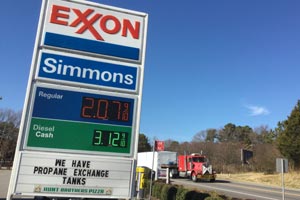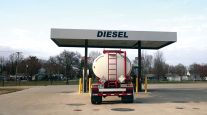Diesel Drops 7.6¢ to $3.137 as Crude Falls Below $50

This story appears in the Jan. 12 print edition of Transport Topics.
Diesel prices began the new year the same way they finished 2014, with the U.S. retail average falling 7.6 cents to $3.137 a gallon, the Department of Energy reported.
The decline, which left trucking’s main fuel 77.3 cents below the first week of 2014, came as crude oil fell below $50 a barrel for the first time in almost six years.
Diesel is the lowest since November 2010 and has risen in just one week since June, a 5.4-cents uptick in early November.
Retail gasoline also extended its decline, falling 8.5 cents to an almost six-year low $2.214. It is more than $1 less than a year earlier, with the average below $2 in both the Midwest and Gulf Coast regions, DOE reported Jan. 5 after its weekly survey of filling stations.
“For trucking customers, this drop in prices is a real boon, and hopefully will translate into improved economic conditions,” said Gene McGillian, an analyst with Tradition Energy in Stamford, Connecticut.
The last time oil was below $50, in April 2009, diesel was about $2.20 a gallon — almost $1 less than it is now — while gas was slightly below its current level.
McGillian attributed today’s higher prices to the comparative strength of the U.S. economy, which was in recession six years ago, as well as recent growth in U.S. diesel exports.
“In the past four or five years, prices have risen significantly as we have exported more distillates to Europe and South America,” he told Transport Topics.
And while lower diesel and gasoline prices would likely follow lower crude prices, cold weather could bump diesel’s price tag higher, he said. That often happens in the winter, when diesel competes with heating oil for distillate stocks.
“Last year, that really seemed to affect the market, but in this environment of lower global prices, we don’t think it will provide much of an uplift for diesel prices,” McGillian said.
Weather forecasts last week showed a short-lived near-term burst of cold weather, in contrast to last year’s repeated “polar vortex” winter blasts, which pushed diesel prices up 26 cents in six weeks to a four-year high $4.159 in late February.
DOE also reported last week that distillate supplies jumped 11.2 million barrels for the week ended Jan. 2, the biggest gain since at least 1982, as refineries’ output hit the highest seasonal level in 16 years, Bloomberg News reported.
Distillate inventories rose to 136.9 million barrels, the highest level in almost three years, DOE said in its Jan. 7 weekly supply report.
Regarding oil prices, McGillian said, “We need to be a little careful . . . that this shock will not continue to affect the economy, so we’ll have to keep watching to see where we bottom.”
Stock markets fell early last week along with lower oil prices — which closed at an almost
six-year low $47.93 a barrel Jan. 6 — before rebounding later in the week.
While shippers are beneficiaries of lower fuel prices through reduced surcharges, carriers also can benefit when prices are falling.
Most fuel surcharge schedules are based on DOE’s weekly fuel prices, said Paul Newbourne, senior vice president of operations for Armada Supply Chain Solutions.
“There’s a week lag, so carriers might be getting paid $3 a gallon on a load that they were actually able to fuel at $2.75,” when prices are falling, said Newbourne, who also is chairman of the National Industrial Transportation League’s highway transportation committee.
He said any gains when prices are falling are generally short-lived because the opposite happens when fuel prices are rising.
“There’s typically a correlation that people who have surcharge schedules that don’t fully compensate carriers for fuel pay higher linehaul rates,” he said. “It’s a little bit of pay me now or pay me later.”
Armada contracts with 180 for-hire carriers, and “in a perfect world, I would have fuel surcharge custom-designed for each carrier, reflecting the efficiency or inefficiency of their operation,” Newbourne said.




